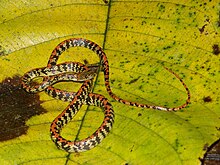
Lepidophyma is a genus of lizards, commonly called tropical night lizards. The genus Lepidophyma is one of three genera of night lizards, which are a group of viviparous (live-bearing) lizards. There are 20 species of tropical night lizards in the genus Lepidophyma, making it the most populous night lizard genus. Species of the genus Lepidophyma are distributed throughout Central America, found anywhere from central Mexico to Panama, depending on the particular species. Tropical night lizards, particularly the yellow-spotted species, are sometimes called Central American bark lizards by pet dealers and owners.
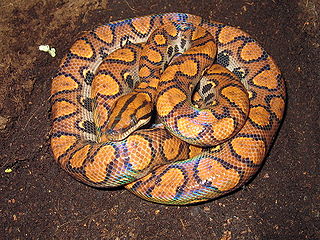
The rainbow boa is a boa species endemic to Central and South America. A semi-arboreal species, it is known for its attractive iridescent/holographic sheen caused by structural coloration. Five subspecies are currently recognized, including the nominate subspecies described here.

Clelia is a genus of snakes, one of three genera with species with the common name mussurana or musurana It is a genus of large snakes in the family Colubridae. The genus is endemic to Central America and South America, and species of Clelia are found from southern Mexico to Brazil. They specialize in ophiophagy, i.e., they attack and eat other snakes. Currently seven species are recognized as being valid. They have other popular names in various countries, such as zopilota in Central America and cribo on some Caribbean islands.

Siphlophis cervinus, the Panamanian spotted night snake or Panama spotted night snake, is a snake found in Amazonian South America and Trinidad and Tobago.
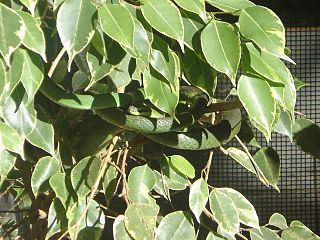
Chironius is a genus of New World colubrid snakes, commonly called sipos, savanes, or sometimes vine snakes. There are 23 described species in this genus.

Tantilla is a large genus of harmless New World snakes in the family Colubridae. The genus includes 66 species, which are commonly known as centipede snakes, black-headed snakes, and flathead snakes.
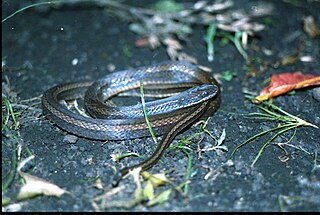
Coniophanes is a genus of colubrid snakes, commonly referred to as black-striped snakes, but they also have many other common names. The genus consists of 17 species, and despite the common name, not all of them display striping.
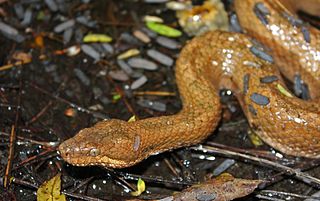
Tropidophis, common name Caribbean dwarf boas, wood snakes or West Indian wood snakes, is a genus of dwarf boas endemic to the West Indies and South America. Currently, either 17 or 33 species are recognized, depending on the authority.

Corallus cropanii, or Cropani's tree boa, is a species of boa, a snake in the family Boidae. The species is endemic to the state of São Paulo, Brazil. Like all boas, it is not venomous. No subspecies are currently recognized. Until 2017, no specimen of this snake had been seen alive since 1953 and only five dead specimens had been collected since then, but in late January 2017, an adult female Cropan's tree boa measuring 1.7 m was captured by locals in Ribeira who brought it to herpetologists from the Instituto Butantan and the Museum of Zoology of the University of São Paulo, who radio-tagged and released the animal to learn more about the species' behavior.

Spalerosophis is a small genus of snakes in the family Colubridae.

Typhlophis is a monotypic genus created for the blind snake species, Typhlophis squamosus, found along the Atlantic coast of South America from the Guianas to Pará in Brazil, as well as in Trinidad. No subspecies are currently recognized.

Porthidium lansbergii is a species of venomous snake, a pitviper in the family Viperidae. The species is endemic to Central and South America. Four subspecies are recognized, including the nominate subspecies described here.
The spotted mulga snake, also known commonly as Butler's black snake and Butler's snake, is a species of venomous snake in the family Elapidae. The species is endemic to Western Australia. It is a member of the genus Pseudechis, dangerously venomous snakes that can intimidate an opponent by raising the head and presenting a hood. This cobra-like threat display is supported by the ability to produce a very large amount of venom.

The big-scaled blind snake is a species of snake in the family Leptotyphlopidae. The species is endemic to southern Central America and northern South America.
Trimetopon is a genus of snakes in the family Colubridae. The genus is native to Costa Rica and Panama. Species in the genus Trimetopon are known commonly as tropical ground snakes.

Siphlophis leucocephalus, commonly known as the common spotted night snake, is a species of snake of the family Colubridae. It is endemic to southeastern Brazil and known from Bahia, Goiás, and Minas Gerais states.
Siphlophis ayauma, the Devil's Head spotted night snake, is a snake found in Ecuador.

Siphlophis longicaudatus, the Brazilian spotted night snake, is a snake found in Brazil.
Siphlophis pulcher, the Guanabara spotted night snake, is a snake found in Brazil.

Siphlophis worontzowi, Worontzow's spotted night snake, is a snake found in Brazil, Peru, and Bolivia.
